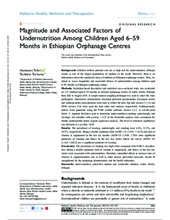Background: Children without parental care are at high risk for under-nutrition. Ethiopia counts as one of the largest populations of orphans in the world. However, there is no information about the nutritional status of children in Ethiopian orphanage centers. Thus, we aimed to assess magnitude and associated factors of undernutrition among children aged 6–59 months in Ethiopian orphanage centres.
Methods: Institution-based descriptive and analytical cross-sectional study was conducted on 227 children aged 6–59 months in selected orphanage centers of Addis Ababa, Ethiopia from July to August 2019. A simple random sampling technique was used to select the study participants. Interviewer administered structured pretested questionnaire, document review and anthropometric measurements were used to collect the data. Epi info version 7.2.1.0 and SPSS version 23.0 were used for data entry and analysis respectively. Anthropometric indices were generated using the WHO Anthro software version 3.2.2. A cut-off point below -2 standard deviation used to determine under-nutrition (stunting, underweight, and wasting). All variables with p-value < 0.25 in the bivariable analysis were considered for further multivariable binary logistic regression analysis. The level of statistical significance was declared at a p-value <0.05.
Results: The prevalence of wasting, underweight, and stunting were 4.4%, 12.3%, and 34.8%, respectively. Being a double orphaned child [AOR= 2.9 (1.201, 7.167)] and lack of vitamin A supplement in the last six months (AOR=1.9 (1.049, 3.799) were significant predictors of stunting and illness in the last two weeks before the survey [AOR= 4.9 (1.345, 1.865)] was a significant predictor of wasting.
Conclusion: The prevalence of stunting was high when compared with WHO’s classification. Being a double orphaned, lack of vitamin A supplement, and illness in the last two weeks were associated with undernutrition. Therefore, intensified efforts to increase rates of vitamin A supplementation and as well as other disease prevention measures should be strengthened by the orphanage administrators and the health authorities.

